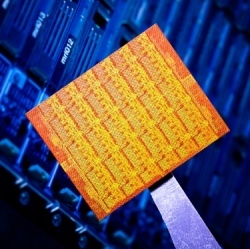
UK researchers say they have achieved data transmission speeds of 10Gbit/s via "li-fi" – wireless internet connectivity using light. The researchers used a micro-LED light bulb to transmit 3.5Gbit/s via each of the three primary colours – red, green, blue – that make up white light.
Li-fi is an emerging technology that could see specialised LED lights bulbs providing low-cost wireless internet connectivity almost everywhere.
EPSRC’s Ultra-parallel visible light communications (UP-VLC) project is running from October 2012 to September 2016.
The vision is built on the unique capabilities of gallium nitride (GaN) optoelectronics to combine optical communications with lighting functions, and especially on the capability to implement new forms of spatial multiplexing, where individual elements in high-density arrays of GaN based light emitting diodes (LEDs) provide independent communications channels, but can combine as displays.
We envisage ultra-high data density – potentially Terabit per second per square millimeter – arrays of LEDs driven via CMOS control electronics in novel addressing and encoding schemes and in compact and versatile forms.
The tiny micro-LED bulbs, developed by the University of Strathclyde, Glasgow, allow streams of light to be beamed in parallel, each multiplying the amount of data that can be transmitted at any one time.
"If you think of a shower head separating water out into parallel streams, that’s how we can make light behave," said Prof Harald Haas, an expert in optical wireless communications at the University of Edinburgh and one of the project leaders.
Using a digital modulation technique called Orthogonal Frequency Divisional Multiplexing (OFDM), researchers enabled micro-LED light bulbs to handle millions of changes in light intensity per second, effectively behaving like an extremely fast on/off switch.
This allows large chunks of binary data – a series of ones and zeros – to be transmitted at high speed.
